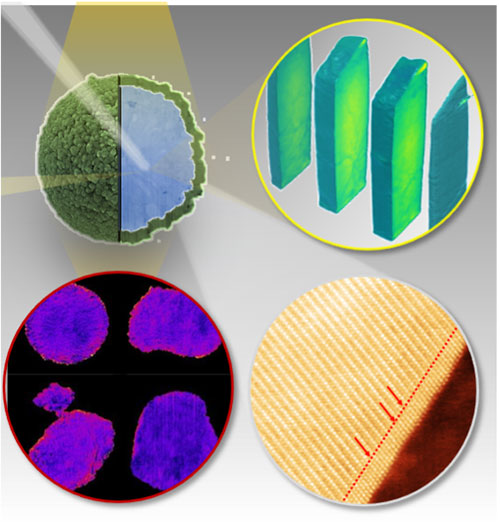Stable Cathode Design for Next-Gen EV Batteries
Scientists discover new approach to stabilize cathode materials
June 30, 2021
 enlarge
enlarge
Multimodal and multi-length scale x-ray- and electron-based imaging and spectroscopic techniques revealed unique structural characteristics of the valence gradient Ni-rich cathode material and mechanisms of improved battery performance. Image credit: Brookhaven National Laboratory
The Science
Scientists identified a new cathode design by confirming an elusive material property called the valance gradient effect, which can stabilize high-nickel-content cathodes.
The Impact
High-nickel-content cathodes offer a pathway to longer-lasting electric vehicle (EV) batteries due to their high capacity; however, these cathodes degrade quickly. This study offers a solution for the degradation problem by stabilizing the cathode material.
Summary
High-nickel-content cathodes have captured the attention of scientists due to their high capacity, a chemical property that could power electric vehicles (EV) over much longer distances than current batteries allow. Unfortunately, the high nickel content also causes these cathode materials to degrade more quickly, creating cracks and stability issues as the battery cycles.
In search of solutions to these structural problems, scientists have synthesized materials made with a nickel concentration gradient, in which the concentration of nickel gradually changes from the surface of the material to its center, or the bulk. These materials have exhibited enhanced stability, but scientists have not been able to determine if the concentration gradient alone was responsible for the improvements. The concentration gradient has traditionally been inseparable from another effect called the valence gradient, or a gradual change in nickel’s oxidation state from the surface of the material to the bulk.
In this study, a team of researchers synthesized a unique material that isolated the valence gradient from the concentration gradient. Once the material was synthesized, the team used the Hard X-ray Nanoprobe (HXN), X-ray Powder Diffraction (XPD), and the Full Field X-ray Imaging (FXI) beamlines at the National Synchrotron Light Source II (NSLS-II) to analyze their material. NSLS-II is a U.S. Department of Energy (DOE) user facility located at DOE’s Brookhaven National Laboratory. In addition to their studies on the beamlines, the team also used the Electron Microscopy Facility at the Center for Functional Nanomaterials (CFN) – also a DOE Office of Science user facility at Brookhaven Lab.
By combining the capabilities of both beamlines and CFN, the researchers were able to visualize the atomic-scale structure and chemical makeup of their sample in 3D after the battery operated over multiple cycles. Their findings demonstrated that the valence gradient can serve as a new approach for stabilizing the structure of high-nickel-content cathodes against degradation and safety issues.
Download the research summary slide
Related Links
Brookhaven Press Release: Scientists Discover New Approach to Stabilize Cathode Materials
Contact
Ruoqian Lin
Chemistry Division, BNL
rulin@bnl.gov
Seongmin Bak
National Synchrotron Light Source II
smbak@bnl.gov
Huolin L. Xin
University of California, Irvine
huolin.xin@uci.edu
Xiao-Qing Yang
Chemistry Division, BNL
xyang@bnl.gov
Publications
R. Lin, SM. Bak, Y. Shin, R. Zhang, C. Wang, K. Kisslinger, M. Ge, X. Huang, Z. Shadike, A. Pattammattel, H. Yan, Y. Chu, J. Wu, W. Yang, M. S. Whittingham, H. L. Xin, X.-Q. Yang. Hierarchical nickel valence gradient stabilizes high-nickel content layered cathode materials. Nature Communication 12, 2350 (2021). DOI: 10.1038/s41467-021-22635-w
Funding
Dr. Ruoqian Lin, Dr. Seongmin Bak, and Dr. Xiao-Qing Yang were supported by the Assistant Secretary for Energy Efficiency and Renewable Energy, Vehicle Technology Office of the U.S. Department of Energy through the Advanced Battery Materials Research (BMR) Program, including Battery500 Consortium under Contract DE-SC0012704. Work done by Dr. Chunyang Wang and Dr. Huolin Xin was supported by the U.S. Department of Energy’s Office of Energy Efficiency and Renewable Energy (EERE) under the Award Number: DE-EE0008444 and the startup funding of Huolin Xin. Mr. Rui Zhang was supported by the startup funding of Huolin Xin. Dr. Y. Shin was supported by the Office of Vehicle Technologies of the U. S. Department of Energy under contract number DE-AC02-06CH11357. Dr. S. Whittingham is supported by the Assistant Secretary for Energy Efficiency and Renewable Energy, Vehicle Technology Office of the U.S. DOE through the Advanced Battery Materials Research (BMR) Program, including Battery500 Consortium under contract No. DE-EE0007765. This research used resources of the Center for Functional Nanomaterials, which is a U.S. DOE Office of Science Facility, and the Scientific Data and Computing Center, a component of the Computational Science Initiative, at Brookhaven National Laboratory under Contract No. DE-SC0012704. This research used resources 3-ID, 18-ID, and 28-ID-2 of the National Synchrotron Light Source II, a U.S. Department of Energy (DOE) Office of Science User Facility operated for the DOE Office of Science by Brookhaven National Laboratory under Contract No. DE-SC0012704. Soft x-ray characterization was carried out at the Advanced Light Source (ALS), a US Department of Energy, Office of Science User Facility under Contract No. DE-AC02-05CH11231. The XRD experiments were carried out at Beamline 17-BM-B of the Advanced Photon Source (APS), which is supported by the U.S. Department of Energy, Office of Science, and Office of Basic Energy Science, under Contract No. DE-AC02-06CH11357.
2021-19016 | INT/EXT | Newsroom









